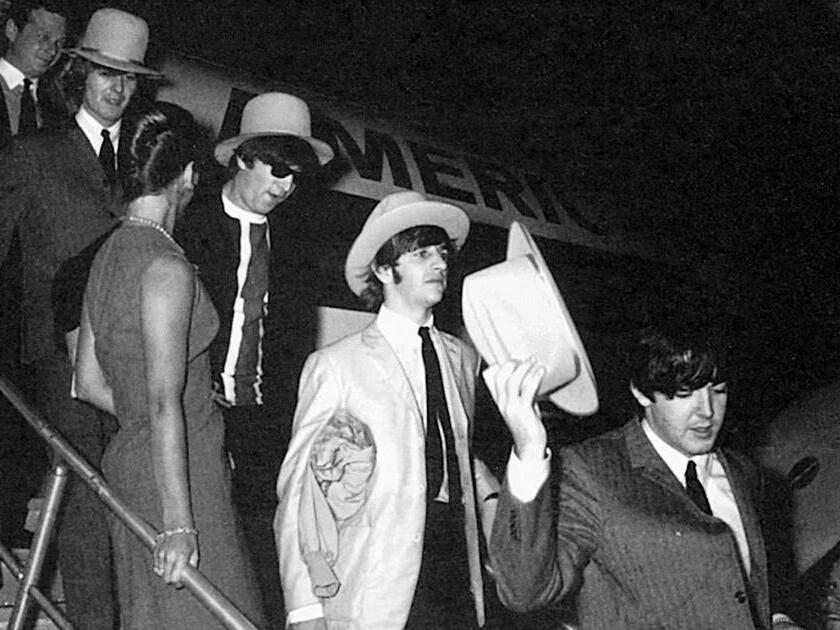Physical Address
304 North Cardinal St.
Dorchester Center, MA 02124
Physical Address
304 North Cardinal St.
Dorchester Center, MA 02124

DENVER • From the main entrance of the Brown Palace Hotel, Debra Faulkner steps away from the hustle and bustle, heading towards an inconspicuous door. A swipe of her employee ID opens it, revealing a kitchen and a staircase. Descending into the dark, dingy underbelly of the historic, luxury hotel, Faulkner quips, “Not so glamorous, huh?”
This unglamorous path was once tread by the most glamorous visitors 60 years ago: John Lennon, Paul McCartney, George Harrison, and Ringo Starr.
It was the afternoon of August 26, 1964, during an early stop on a tour that would forever change the music landscape in America.
Beatlemania had descended upon Denver.
The Brown Palace’s grand atrium was flooded with about 5,000 girls, eager to meet the four lads from Liverpool. They had earlier arrived to a crowd of thousands at Stapleton Airport. The Beatles were bound for Red Rocks Amphitheatre, the next scene of pandemonium in their tour across the western U.S. and Vancouver.
This was their first North American tour, and America seemed ill-prepared.
The Rocky Mountain News editorialized: “Attention, teenagers of Denver. You have the opportunity of attracting worldwide attention today! Don’t be rowdies. Don’t throw things. … Don’t kick and elbow. Gird on the self-discipline that is the mark of a true American citizen.”
But that was not to be.
“7 Hospitalized in Beatles Stampede,” read a headline. A girl reportedly broke her foot, and two teens were treated for rib and stomach injuries after being trampled in the rush. Dozens more fainted and swooned at the sight of the singers.
Even the police had their own casualties. One officer was bitten on the wrist by an overenthusiastic girl, another lost a tooth, and one took a hard blow to the gut, losing his nightstick in the process.
The Beatles were only briefly sighted before being whisked away through a side door and led down the steps Faulkner now traverses. For Faulkner, the hotel historian, this is one of her favorite tours.
The elevator button labeled “B” stands for basement, not Beatles. One can’t help but imagine the Fab Four packed in this elevator, possibly panicking during a supposed 5-minute stall, relieved once they reached the eighth floor.
This floor is lined by glass bricks, offering privacy when these rooms were apartments. “Which is why I think they put them up here,” Faulkner notes. “Because it was easy to secure, it was private and quiet.”
Stopping at a hallway, she points to holes in the floor where a gate once was, blocking the way to what is now room 840. The room features framed photos commemorating that raucous Red Rocks show. The window overlooks 18th and Broadway, the same view the Beatles had of the historic Trinity United Methodist Church.
Back in 1964, this was a two-room suite with four twin beds, the biggest stars the Brown Palace had ever hosted. It remains a mystery who among John, Paul, George, and Ringo slept where.
“If they were even able to sleep,” Faulkner ponders.
It’s easy to imagine the Beatles’ first American tour as sleepless — a whirlwind of 32 shows in 33 days.
Some historians today call it America’s first major rock ‘n’ roll tour. Chuck Gunderson’s “Some Fun Tonight!” describes the tour as “record-setting, precedent-setting, groundbreaking, earth-shaking, and moneymaking.”
The ’64 tour “basically began the large-scale concert touring industry we know today,” Gunderson says. Unlike Elvis, who played in high school gymnasiums in the ‘50s, the Beatles’ tour was entirely unprecedented.
They had previously performed on “The Ed Sullivan Show,” watched in one of every four American households. The show shot “I Want to Hold Your Hand” to the top of the charts, sparking adoration and anger across generations.
“It was four guys with a very weird look, very distinct personalities and mannerisms playing off each other in such a way,” Gunderson says. “It had to be like space aliens coming to America.”
Denver had never seen such a phenomenon.
Denver was among the smallest cities they visited on that first tour. Although the tour saw some of the Beatles’ biggest audiences to date, their manager, Brian Epstein, carefully chose venues to avoid overexposure.
“He rejected offers for big stadium shows,” Gunderson notes. “Places like Red Rocks seemed more fitting.”
The Visit Denver remembrance states: “It was the first full-blown rock concert at Red Rocks, though Ricky Nelson and Peter, Paul and Mary had previously performed there.”
The Red Rocks show, like others in the tour, came with rebellion.
In San Francisco, protesters held signs urging fans to turn to God and away from the mopheads. In Vancouver, the show was briefly stopped as the host pleaded for calm. Such scenes were described as “riots” by newspapers.
In Denver, the FBI investigated a threatening letter: “If you know what’s good for you, cancel Denver engagement. I’ll be in the audience and I’m going to throw a hand grenade instead of jelly babies.”
To the relief of the 200 officers at Red Rocks, it was only jelly beans tossed on stage. The amphitheater’s layout, however, made everyone aware of potential dangers, including snipers.
This moment underscored the psychological costs of fame, along with political and generational divides and social expectations. The whole racial climate of America in 1964 was also a backdrop.
During a show at Red Rocks, the Beatles’ Black openers, the Exciters, faced boos and racial slurs. Lillian Walker Moss, one of the singers, ran off in tears but returned to finish the set to a standing ovation and two encores.
Stories from the Beatles’ Denver stay are part legend. They reportedly needed oxygen at Red Rocks due to the altitude. The $6.60 concert ticket was a tough sell, double the typical rate. Rumors claimed they trashed their room, but Faulkner dismisses this. “I’m sure they were just tired and wanted to rest,” she says.
Faulkner herself was captivated by the Beatles as a young girl. She believes the tour was pivotal for young women in America, who found a new culture to celebrate.
Bill Carle remembers girls running away from home to see the Beatles at Red Rocks. Tari O’Connor, who attended the concert as a young girl, describes it as a freeing experience.
She learned to play the guitar and became known as the family’s black sheep, following bands like the Grateful Dead. O’Connor would love to see the Beatles again, but they never returned to Denver. The 1964 tour was a fleeting moment, never to be repeated.
O’Connor now cherishes the memories, still holding on to her air guitar as she sings, “She loves you, yeah, yeah, yeah …”
Source: Denver Post, Visit Denver, “Some Fun Tonight!” by Chuck Gunderson, The Beatles Anthology



